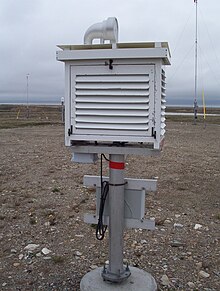Climate garden
The climate garden is a measuring field on which a meteorological measuring station ( weather station ) is located. The appearance of such a measuring field is precisely defined by the World Meteorological Organization (WMO).
A climate hut developed by Thomas Stevenson (1818–1887) is used to protect the equipment ; the Stevenson Screen named after him . For synoptic observations, this climate hut has to stand on a support exactly two meters above the ground in an international comparison. The subsurface should be short lawn and the distance from the hut to any buildings should be as far as the object is high. Furthermore, there are rain gauges at a height of 1 m and various soil thermometers at a depth of 5, 10, 20, 50 and 100 cm in this climatic garden .
The soil minimum thermometer, on the other hand, is on a holder and free at a height of 5 cm above bare ground. The anemometer , which can be a Wild wind vane or an anemometer , must be mounted on a 10 m high mast. A sunshine autograph and possibly sensors for measuring global radiation also belong to such a climate garden .

